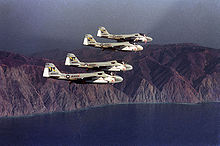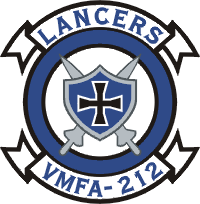
Marine Fighter Attack Squadron 212 (VMFA-212) was a United States Marine Corps F/A-18 Hornet squadron. Most recently known as the "Lancers", the squadron was last based at Marine Corps Air Station Iwakuni, Japan and fell under the command of Marine Aircraft Group 12 (MAG-12) and the 1st Marine Aircraft Wing. VMFA-212 has an extensive combat history having participated in combat operations during World War II, the Korean War, Vietnam War, the Gulf War, and Operation Enduring Freedom. Due to a re-organization within Marine aviation, the squadron was deactivated in 2008.

Marine Corps Air Station Iwakuni or MCAS Iwakuni is a joint Japan Maritime Self-Defense Forces and United States Marine Corps air station located in the Nishiki river delta, 1.3 NM southeast of Iwakuni Station in the city of Iwakuni, Yamaguchi Prefecture, Japan.

Marine Fighter Attack Squadron 232 (VMFA-232) is a United States Marine Corps F/A-18 Hornet squadron. Nicknamed the "Red Devils", the squadron is based at Marine Corps Air Station Miramar, California and falls under the command of Marine Aircraft Group 11 (MAG-11) and the 3rd Marine Aircraft Wing. The Red Devils are the oldest and most decorated fighter squadron in the Marine Corps.
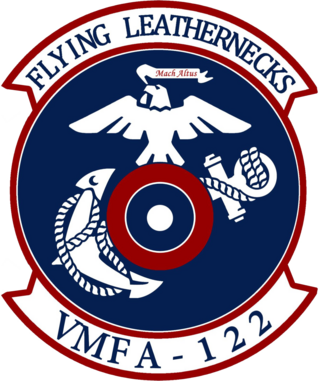
Marine Fighter Attack Squadron 122 (VMFA-122) is a United States Marine Corps fighter attack squadron flying the F-35B Lightning II. The squadron is based out of Marine Corps Air Station Yuma, AZ and falls under the command of Marine Aircraft Group 13 (MAG-13) and the 3rd Marine Aircraft Wing. The squadron nickname is the "Flying Leathernecks," and their traditional radio call sign is "Nikel". On 14 November 2017, VMFA-122 opened a new chapter of their history, transitioning from the McDonnell Douglas F/A-18C Hornet to the Lockheed Martin F-35B Lightning II and moving from MCAS Beaufort and MAG-31, 2nd MAW to MCAS Yuma and MAG-13, 3rd MAW.

Marine Fighter Attack Squadron 211 (VMFA-211) is a United States Marine Corps fighter attack squadron, currently consisting of F-35B Lightning II stealth STOVL strike fighter jets. Known as the "Wake Island Avengers" and the "Bastion Defenders", the squadron is based at Marine Corps Air Station Yuma, Arizona and falls under the command of Marine Aircraft Group 13 (MAG-13) and the 3rd Marine Aircraft Wing.
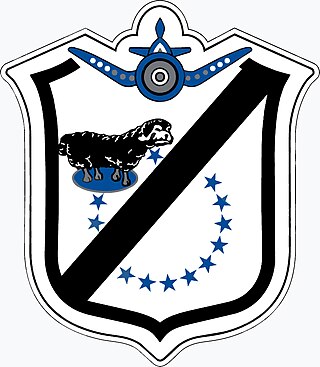
Marine Fighter Attack Squadron 214 (VMFA-214) is a United States Marine Corps fighter attack squadron that currently flies the Lockheed Martin F-35B Lightning II. The squadron's home field is Marine Corps Air Station Yuma, Arizona, and it is assigned to Marine Aircraft Group 13 (MAG-13) of the 3rd Marine Aircraft Wing.

Marine Fighter Attack Training Squadron 502 (VMFAT-502) is a United States Marine Corps fighter attack training squadron flying the Lockheed Martin F-35 Lightning II. Known as the "Flying Nightmares", the squadron maintains the history of Marine Attack Squadron 513 (VMA-513) which dates back to World War II and was decommissioned on 12 July 2013. The squadron is based at Marine Corps Air Station Miramar and falls under the command of Marine Aircraft Group 11 and the 3rd Marine Aircraft Wing
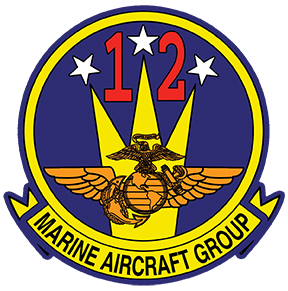
Marine Aircraft Group 12 (MAG-12) is an active air group of the United States Marine Corps, tasked with providing fighter and assault support aircraft. It is currently part of the 1st Marine Aircraft Wing, itself an integral part of the III Marine Expeditionary Force, and based at MCAS Iwakuni in Japan.

Marine Fighter Attack Squadron 115 (VMFA-115) was a United States Marine Corps F/A-18 Hornet squadron. Officially nicknamed the "Silver Eagles" and on occasion Joe's Jokers after their first commanding officer Major Joe Foss, the squadron was last based at Marine Corps Air Station Beaufort, South Carolina and fell under the command of Marine Aircraft Group 31 (MAG-31) and the 2nd Marine Aircraft Wing. The squadron participated in combat operations during World War II, the Korean and Vietnam Wars and has deployed in support of Operation Iraqi Freedom with a final deployment in 2008 to Al Asad Airbase in western Iraq. The Squadron radio callsign was "Blade".

Marine Fighter Attack Squadron 542 (VMFA-542) is a United States Marine Corps Aviation fighter attack squadron flying the F-35B Lightning II. VMFA-542 is based at Marine Corps Air Station Cherry Point, North Carolina and falls under the command of Marine Aircraft Group 14 (MAG-14) and the 2nd Marine Aircraft Wing.
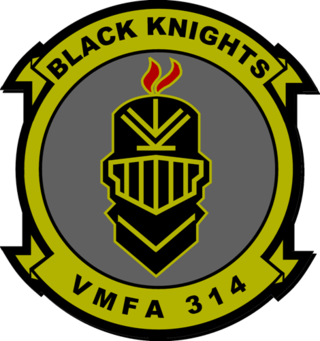
Marine Fighter Attack Squadron 314 (VMFA-314) is a United States Marine Corps F-35C Lightning II squadron. The squadron, known as the "Black Knights", is based at Marine Corps Air Station Miramar, California and falls under the command of Marine Aircraft Group 11 (MAG-11) and the 3rd Marine Aircraft Wing, but deploys with the US Navy's Carrier Air Wing Nine (NG).
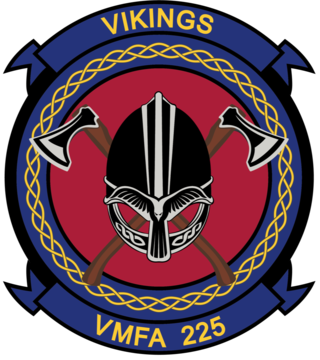
Marine Fighter Attack Squadron 225 (VMFA-225) is a United States Marine Corps fighter attack squadron flying the F-35B Lightning II. The squadron, known as the "Vikings", is based at Marine Corps Air Station Yuma in Arizona and falls under the command of Marine Aircraft Group 13 (MAG-13) and the 3rd Marine Aircraft Wing.

Marine All Weather Fighter Attack Squadron 224 is a United States Marine Corps (USMC) F/A-18 Hornet squadron. Also known as the "Fighting Bengals", the squadron is based at Marine Corps Air Station Beaufort, South Carolina and falls under the command of Marine Aircraft Group 31 (MAG-31) and the 2nd Marine Aircraft Wing. The Bengals are the only Marine F/A-18D Hornet Squadron currently operating out of MCAS Beaufort.
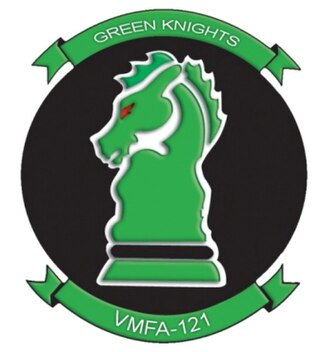
Marine Fighter Attack Squadron 121 (VMFA-121), also known as the "Green Knights", is a United States Marine Corps aircraft squadron operating the F-35B Lightning II. The squadron is based at Marine Corps Air Station Iwakuni, Japan and falls under the command of Marine Aircraft Group 12 (MAG-12) and the 1st Marine Aircraft Wing. Their tail code is VK and their radio call sign is "Combat".

Marine Aircraft Group 13 is a United States Marine Corps aviation unit based at Marine Corps Air Station Yuma that is currently composed of one McDonnell Douglas AV-8B Harrier II squadron, three Lockheed Martin F-35B Lightning II squadrons, an unmanned aerial vehicle squadron, a maintenance and logistics squadron, and a wing support squadron. The group falls under the command of the 3rd Marine Aircraft Wing and the I Marine Expeditionary Force.

Marine Fighter Attack Squadron 533 (VMFA-533) is a United States Marine Corps F-35B squadron. Also known as the "Hawks", the squadron is based at Marine Corps Air Station Beaufort, South Carolina and falls under the command of Marine Aircraft Group 31 (MAG-31) and the 2nd Marine Aircraft Wing.

VMFA(AW)-332 Marine All Weather Fighter Attack Squadron 332 was a United States Marine Corps F/A-18 Hornet squadron. Also known as the "Moonlighters", the squadron was based at Marine Corps Air Station Beaufort, South Carolina as part of Marine Aircraft Group 31 (MAG-31), 2nd Marine Aircraft Wing. The squadron flew its last flight in the F/A-18 Hornet on 30 March 2007. At the time of their deactivation, they held the longest streak of mishap-free flight hours for a tactical jet squadron at 109,000 hours.
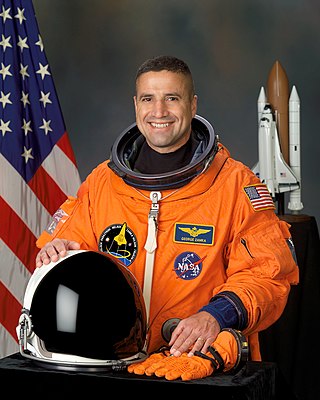
George David "Zambo" Zamka is a former NASA astronaut and United States Marine Corps pilot with over 3500 flight hours in more than 30 different aircraft. Zamka piloted the Space Shuttle Discovery in its October 2007 mission to the International Space Station and served as the commander of mission STS-130 in February 2010.

Marine Tactical Reconnaissance Squadron 3 (VMFP-3) was an aviation unit of the United States Marine Corps active between 1975 and 1990.



